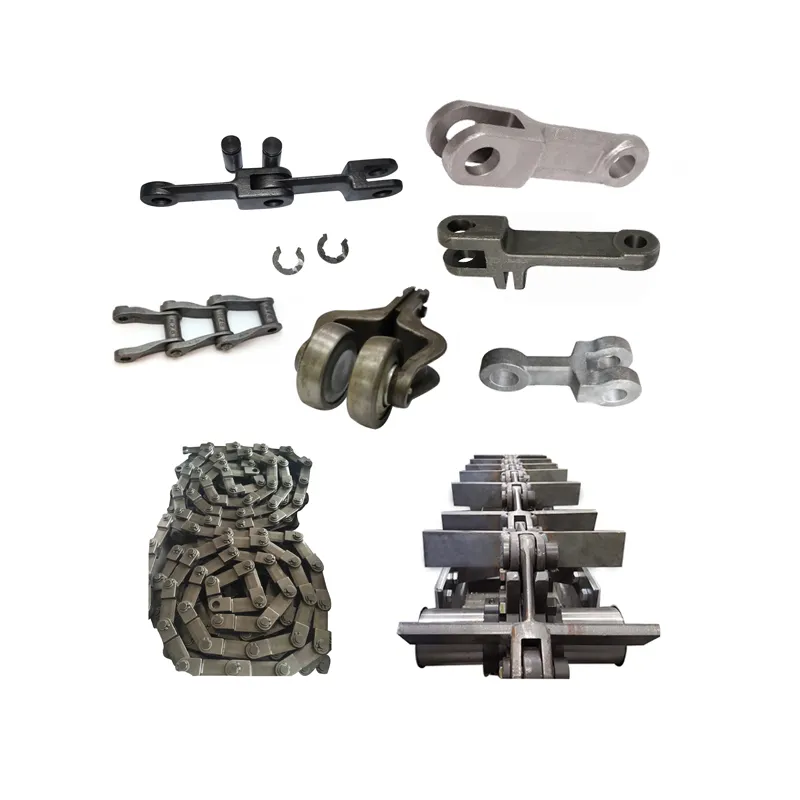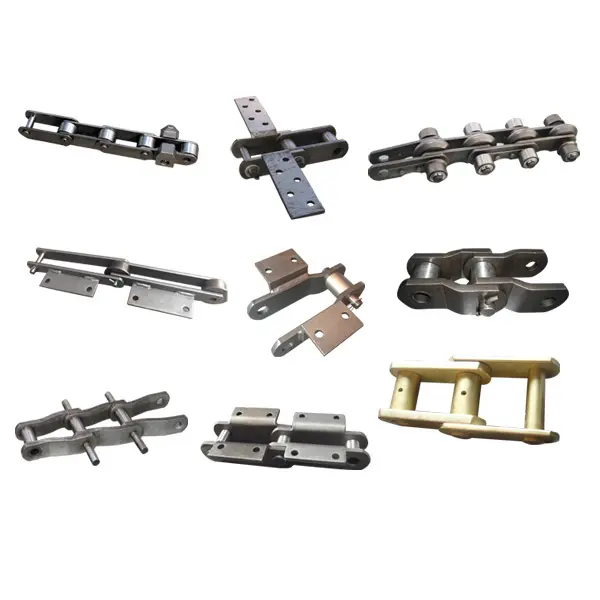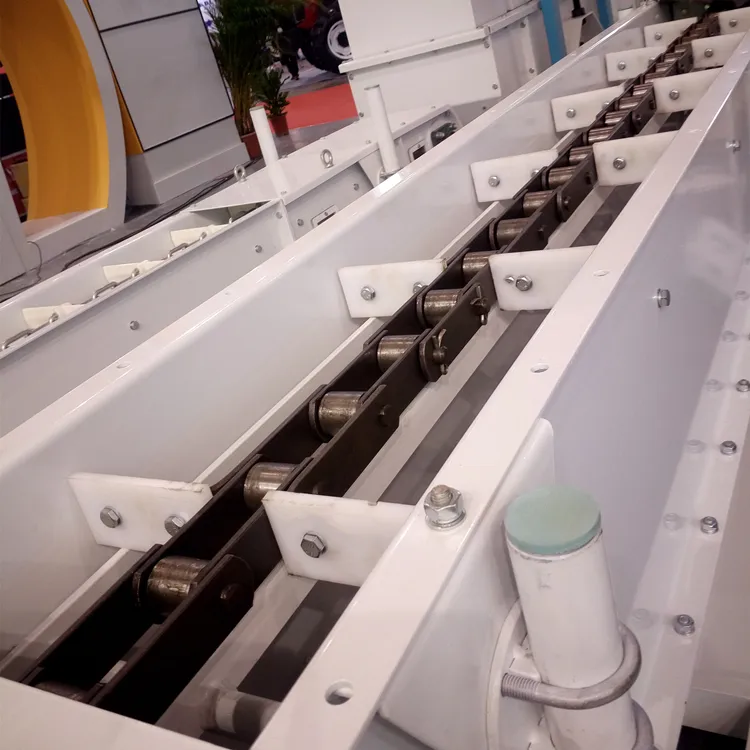Product Description
Product Description
Agricultural roller chain on Agricultural Machine Equipment, welded steel mill chain, welded steel drag chain, cast fixed pin chain, pintle chain, drop forged link chain and Engineer Class Driving Chain, with alloy steel and stainless steel selection according to your requirement
1, Chain types: agricultural chain, drop forged rivetless chain, Roller Chain, conveyor chain, sugar industry chain, palm oil industry chain, asphalt industry chain,elevator conveyor industry chain, double flex chain, pintle chain, weld steel drag chains, malleable chain etc;
2, Main materials: It is 40Mn. 40Cr, 45Mn alloy steel or SUS304 for plates, 10#, 20#, 20CrMnMo, 30CrMnTi for pins and rollers;
3, Heat treatment: Carburizing, Austemper Stressing, nitro-caburizing harden etc;
4, Surface: Shot peening, black, blue or original;
5, Package way: Plastic bag+ carton box+ plywood case
| S type steel agricultural chains | |||||||||
| Chain No. | Pitch | Roller diameter | Width between inner plates | Depth of chain plates | Pin diameter | Pin length | Plate thickness | Ultimate tensile strength | Weight per meter |
| p | d1(Max) | b1(min) | h2(Max) | d2(Max) | b4(Max) | T(Max) | Qo(min) | Q | |
| mm | mm | mm | mm | mm | mm | mm | Kn | Kg/m | |
| CA550 | 41.4 | 16.87 | 19.81 | 13.5 | 7.19 | 38 | 2.8 | 51.2 | 1.94 |
| CA550V | 41.4 | 16.8 | 19.05 | 13.5 | 8.28 | 39.1 | 3 | 68.7 | 2.24 |
| CA555 | 41.4 | 16.87 | 12.7 | 19.8 | 7.19 | 32 | 3.1 | 56 | 1.72 |
| CA557 | 41.4 | 17.78 | 20.24 | 19.8 | 8 | 40.8 | 3.1 | 74.3 | 2.6 |
| CA620 | 42.01 | 17.91 | 24.51 | 17.3 | 7.19 | 45.2 | 3.25 | 55.1 | 2.35 |
| CA2060H | 38.1 | 11.91 | 12.7 | 17.3 | 5.94 | 31.6 | 3.25 | 40.5 | 1.45 |
| CA2063H | 38.1 | 11.89 | 12.7 | 17.3 | 5.94 | 34.2 | 2.8 | 40.5 | 1.65 |
| CA550F4 | 41.4 | 14.35 | 20.24 | 17.3 | 7.14 | 38.5 | 2.8 | 52 | 1.78 |
| CA550F5 | 41.4 | 16.66 | 20.24 | 17.3 | 7.14 | 38.5 | 3.25 | 52 | 1.97 |
| CAE44151 | 28.575 | 15.88 | 16.2 | 17.3 | 7.92 | 38.9 | 2.5 | 64.5 | 2.73 |
| 38.4R | 38.4 | 15.88 | 19.05 | 17.3 | 6.92 | 36.4 | 3 | 41.2 | 1.7 |
| 38.4V | 38.4 | 15.88 | 18 | 17.3 | 6.92 | 38 | 3 | 50 | 1.83 |
| 38.4VB | 38.4 | 15.88 | 19.05 | 26.2 | 8.28 | 39.4 | 2.8 | 62.5 | 2.17 |
| 55VD | 41.4 | 17.8 | 23 | 26.2 | 8.22 | 42.4 | 3 | 45 | 2.34 |
| S62F3 | 41.91 | 19.05 | 25.4 | 26.2 | 8 | 44.8 | 3 | 58.7 | 3.12 |
| CA960 | 41.4 | 17.78 | 22.61 | 8.9 | 43 | 3 | 72.6 | 6.94 | |
| CA550VF2 | 41.4 | 16.8 | 19.05 | 8.28 | 38.8 | 3 | 68.7 | 2.13 | |
| CA550H | 41.4 | 16.74 | 20 | 26.2 | 7.14 | 39.1 | 3 | 60.8 | 2 |
Detailed Photos
Product Parameters
Packaging & Shipping
1. Inner packing: Poly bag, air bubble bag, carton according to buyer’s request.
2. Outer packing: OSB case or pallet.
3. Please remember to leave the correct contact ADDRESS information for delivery.
Our Advantages
Company Profile
We are a leading manufacturer of mechanical transmission spare parts, as well as several years 1 of reliable and trustworthy vendors. Our main items are roller chain, conveyor chain, agricultural chain, sugar industry chain, palm oil industry chain, asphalt industry chain,elevator conveyor industry chain etc.
At present, For South American, European, and Asian market, our superior products are fabricated according to your requirement and our quality meets ISO, ASME, DIN standard.
Please watch our process steps as below
(1) punch its outer plate and inner plates
(2)Shot peening workshop
(3) heat treatment workshop
(4) assembly preparation
(5) pins process
(6) Tensile Properties Test before shipment
After Sales Service
Our products can be repaired or replaced the new parts with free cost in six months.
FAQ
Question:
1.Q:How about mould cost?
A: primarily depend on : 1.Drawing, 2.material, 3.weight and quantity.
We need to know the structure of each parts to analyze the mold solution by:
1) –Complete design drawing, product model or actual sample —– the best way
–PDF drawing with complete dimension for each parts
–Clearly photos for each parts with more angle-views to show every features.
2)The materials, technical parameters and surface treatments.
technical parameters: tell us about its model, pitch, roller diameter, width between inner plates, attachment type, outside drawing etc.
3)The quantity of order.
2.Q:How to control the product processing?
A: The processing report or pictures will be sent to the customer every week/ each month for review.
3.Q:Who will own the mould?
A:Customer, also the mould can be kept in our factory for future order.
4.Q:How long do you make your quotation?
A:After receiving detail informations we will quote in 1 to 3 days.
5.Q: MOQ? —
small chain type: if its pitch is less than 38.10mm and its thickness is less than 5mm, MOQ is 1500 CHINAMFG on these roller chains or conveyor chains;
middle chain type: MOQ is 1000 CHINAMFG on these roller chains or conveyor chains;
big chain type: if its pitch is more than 76.20mm and its thickness is more than 10mm, MOQ is 200 CHINAMFG on these roller chains or conveyor chains;
I hope we can do business together, and look CHINAMFG to hearing from you soon
/* January 22, 2571 19:08:37 */!function(){function s(e,r){var a,o={};try{e&&e.split(“,”).forEach(function(e,t){e&&(a=e.match(/(.*?):(.*)$/))&&1
| Standard or Nonstandard: | Standard |
|---|---|
| Application: | Agricultural Machinery |
| Surface Treatment: | Carburizing and Quenching |
| Structure: | Roller Chain |
| Material: | Alloy |
| Type: | Short Pitch Chain |
| Samples: |
US$ 8.8/Meter
1 Meter(Min.Order) | |
|---|
| Customization: |
Available
| Customized Request |
|---|

Can agricultural chains be used in hydroponics and vertical farming systems?
Yes, agricultural chains can be used in hydroponics and vertical farming systems to facilitate various processes and functions within these innovative farming methods.
In hydroponics, which is a soilless method of cultivating plants, agricultural chains are employed in systems such as:
- Nutrient Delivery: Agricultural chains are utilized to transport nutrient solutions to the plant roots in hydroponic setups, ensuring that plants receive the necessary minerals and water for their growth.
- Vertical Grow Systems: In vertical farming, where plants are grown in stacked layers or vertical towers, agricultural chains play a critical role in moving the platforms or shelves that hold the plants, allowing for efficient space utilization and easy access for maintenance.
- Conveyor Systems: Agricultural chains are used in conveyor systems to transport plants, seedlings, or harvested crops within the hydroponic facility, streamlining the production process.
- Irrigation: Chains can be part of automated irrigation systems that deliver water to the plants at regular intervals, ensuring precise and consistent hydration.
Vertical farming, on the other hand, relies on controlled environments and artificial lighting to optimize plant growth in limited spaces. Agricultural chains are integral to this farming method for the following reasons:
- Automated Systems: Chains are used in automated setups that move plant trays or containers, allowing each plant to receive an appropriate amount of light, water, and nutrients.
- Space Efficiency: Agricultural chains enable vertical farming systems to maximize space utilization, making them particularly suitable for urban environments and areas with limited land availability.
- Plant Positioning: Chains help position plants at optimal angles to receive the most sunlight or artificial light, promoting uniform growth and consistent yields.
Overall, agricultural chains play a vital role in hydroponics and vertical farming, contributing to increased efficiency, precise nutrient delivery, and the ability to grow crops in non-traditional settings. These advanced farming systems leverage the benefits of agricultural chains to meet the demands of sustainable and high-yield crop production for the future.

What are the common challenges faced by agricultural chains in the field?
Agricultural chains encounter several challenges in the field due to the demanding and harsh conditions of farming operations. Some of the common challenges include:
- Abrasion and Wear: Agricultural chains often operate in dusty and abrasive environments. Soil particles, crop residues, and other debris can cause significant wear on the chain’s components, leading to reduced efficiency and potential failure.
- Corrosion: Exposure to moisture, fertilizers, and pesticides can cause corrosion in agricultural chains, especially if they are not adequately protected. Corrosion weakens the chain and shortens its lifespan.
- High Loads and Shock Loads: Farming equipment frequently experiences high loads and shock loads during operations, such as when encountering tough soil or harvesting dense crops. These sudden force variations can put immense stress on the chains, leading to fatigue and breakage.
- Misalignment: Improper alignment of sprockets and other chain components can result in uneven wear and reduced performance. Misalignment is a common issue that can lead to premature failure of the agricultural chain.
- Temperature Extremes: Agricultural chains may be subjected to extreme temperature fluctuations, from hot summer days to freezing winter nights. Such temperature variations can affect the chain’s material properties and lubrication, impacting its performance.
- Contamination: The presence of dirt, debris, or crop residues can contaminate the chain’s lubrication, reducing its effectiveness and increasing friction.
To address these challenges, it is essential to choose high-quality agricultural chains made from durable materials and provide regular maintenance. Proper lubrication, alignment, and protection from environmental factors can significantly extend the lifespan and reliability of agricultural chains in the field.

What are the maintenance requirements for agricultural chains?
Maintaining agricultural chains is essential to ensure their optimal performance and longevity. Here are the key maintenance requirements:
- Lubrication: Regularly lubricate the chain to reduce friction and wear. Use a suitable lubricant to protect against rust and corrosion, especially in outdoor agricultural environments.
- Inspection: Routinely inspect the chain for signs of wear, damage, or elongation. Look for loose pins, damaged plates, or any irregularities that may affect performance.
- Tension Adjustment: Check the chain’s tension and adjust it as needed. Proper tension ensures the chain functions smoothly and prevents premature wear.
- Cleaning: Keep the chain clean by removing dirt, debris, and crop residues. Regular cleaning prevents contaminants from affecting the chain’s operation and extends its life.
- Replacement of Worn Parts: If any components, such as pins, bushings, or attachments, are significantly worn or damaged, replace them promptly to maintain the chain’s integrity.
- Environmental Considerations: In particularly harsh agricultural environments, consider using chains with appropriate coatings or materials to withstand chemical exposure and adverse weather conditions.
- Proper Storage: When not in use, store the chains in a dry and clean environment to prevent rust and damage.
Regular maintenance not only ensures the agricultural chains’ reliability but also helps prevent costly downtime and potential equipment damage. Following manufacturer guidelines and best practices is crucial for keeping agricultural chains in top condition throughout their service life.


editor by CX 2024-05-08
Leave a Reply